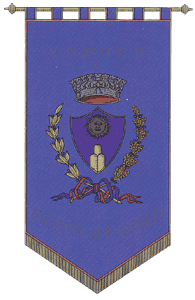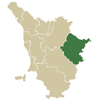|
 Inhabitants in 1991 : 2,859
Inhabitants in 1991 : 2,859
 The
Municipal territory of Castel San Niccolò in the Valdarno
Casentinese extends over an area of 83,14 square kilometres, on the north
eastern slopes of the ridge of Pratomagno, from the highest part of the
crest (Croce di Pratomagno, 1,591metres high) to the influx of the Solano
stream with the Arno, on the plains of Campaldino, which in Roman times
was crossed by roads which came from Firenze towards Pelago reaching Montemignaio
and thus to Vado, where it adjoined the more important Casentinese road.
A feudal centre, then Medieval Podesta office, in 1808 it
was deprived of the hamlet of Montemignaio, with rights of the Seat of
municipality ; it arrived at its present position in 1868, with the
acquisition of the hamlets of Battifolle, Caiano, Poggio Vertelli, Ristonchi
and Vertelli all previously part of the municipality of Montemignaio. The
Municipal territory of Castel San Niccolò in the Valdarno
Casentinese extends over an area of 83,14 square kilometres, on the north
eastern slopes of the ridge of Pratomagno, from the highest part of the
crest (Croce di Pratomagno, 1,591metres high) to the influx of the Solano
stream with the Arno, on the plains of Campaldino, which in Roman times
was crossed by roads which came from Firenze towards Pelago reaching Montemignaio
and thus to Vado, where it adjoined the more important Casentinese road.
A feudal centre, then Medieval Podesta office, in 1808 it
was deprived of the hamlet of Montemignaio, with rights of the Seat of
municipality ; it arrived at its present position in 1868, with the
acquisition of the hamlets of Battifolle, Caiano, Poggio Vertelli, Ristonchi
and Vertelli all previously part of the municipality of Montemignaio.
The castle of San Niccolò was, since the XIII century, one
of the most fortified fortresses owned by the Counts Guidi in the Casentino.
In 1342 the population, oppressed by the despotic governing of their Lord,
Count Galeotto, rebelled and managed to oust him. Castel San Niccolò
was given up spontaneously to Firenze and was made capital of a
vast Podesta tenure, called della Montagna Fiorentina, comprising Montemignaio,
Battifolle, Borgo alla Collina and Ortignano ; The acquisition of
the municipality as part of the Fiorentina republic was sanctioned in
1359, with a public decree signed by the Count Marco dei Guidi. In
1440 the castle was protagonist of a long resistance to the state of siege
by the troops of Niccolò Piccinino. After its decline, the
inferior Borgo di Vado (born in medieval times as the castle’s market
and called thus probably because it was formed near the ford of the Solano
stream) acquired more importance and was renamed Strada, a town name which
clearly indicates its origins, and that its development was due to its
position on an important thoroughfare.
Historical info reproduced upon authorization of Regione Toscana - Dipartimento della Presidenza E Affari Legislativi e Giuridici
Translated by Ann Mountford
|